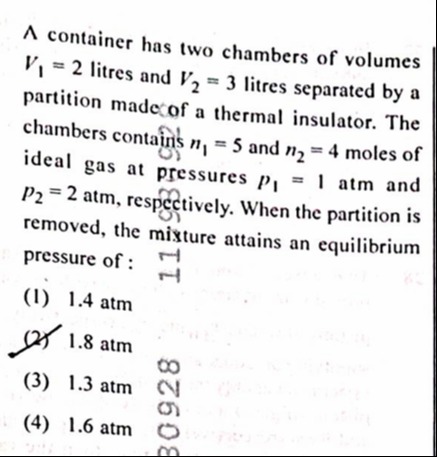Question
Question: A container has two chambers of volumes $V_1$ = 2 litres and $V_2$ = 3 litres separated by a partiti...
A container has two chambers of volumes V1 = 2 litres and V2 = 3 litres separated by a partition made of a thermal insulator. The chambers contains n1 = 5 and n2 = 4 moles of ideal gas at pressures P1 = 1 atm and P2 = 2 atm, respectively. When the partition is removed, the mixture attains an equilibrium pressure of :

1.4 atm
1.8 atm
1.3 atm
1.6 atm
1.6 atm
Solution
The mixing process is assumed to be adiabatic and involve no work, leading to conservation of total internal energy. For ideal gases, internal energy U=nCvT. Conservation of internal energy means n1CvT1+n2CvT2=(n1+n2)CvTf. Using the ideal gas law PV=nRT, we have nT=PV/R. Substituting this into the energy conservation equation gives RP1V1Cv+RP2V2Cv=RPf(V1+V2)Cv. This simplifies to P1V1+P2V2=Pf(V1+V2). Solving for Pf: Pf=V1+V2P1V1+P2V2. Plugging in the given values V1=2 L, P1=1 atm, V2=3 L, P2=2 atm: Pf=2+3(1)(2)+(2)(3)=52+6=58=1.6 atm.
